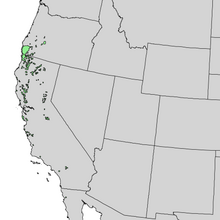Knobcone pine
| Knobcone pine | |
|---|---|

| |
| Scientific classification | |
| Kingdom: | Plantae |
| Clade: | Tracheophytes |
| Clade: | Gymnospermae |
| Division: | Pinophyta |
| Class: | Pinopsida |
| Order: | Pinales |
| Family: | Pinaceae |
| Genus: | Pinus |
| Subgenus: | P. subg. Pinus |
| Section: | P. sect. Trifoliae |
| Subsection: | P. subsect. Australes |
| Species: | P. attenuata
|
| Binomial name | |
| Pinus attenuata | |

| |
The knobcone pine, Pinus attenuata (also called Pinus tuberculata),[2] is a tree that grows in mild climates on poor soils. It ranges from the mountains of southern Oregon to Baja California with the greatest concentration in northern California and the Oregon-California border.[3]
Description
Individual specimens can live up to a century.[4] The crown is usually conical with a straight trunk. It reaches heights of 8–24 meters (26–79 feet),[5] but can be a shrub on especially poor sites. The bark is thin and smooth, flaky and gray-brown when young, becoming dark[4] gray-red-brown and shallowly furrowed into flat scaly ridges in age. The twigs are red-brown and often resinous. Its wood is knotty and of little interest for lumber.[4]
The leaves are in fascicles of three,[6] needle-like, yellow-green, twisted, and 9–15 centimeters (3+1⁄2–6 in) long. The cones are resin-sealed and irregularly shaped,[4] 8–16 cm (3+1⁄4–6+1⁄4 in) long and clustered in whorls of three to six on the branches. The scales end in a short stout prickle. Cones can sometimes be found attached to the trunk and larger branches.[4]
-
Leaves
-
male cones
-
Cones
-
Knobcone pine cone
-
Plant
-
Habitat
Distribution
The knobcone pine can be found growing in the dry, rocky soils of southern Oregon and northern California, between 300 and 750 m (980 and 2,460 ft) above sea level.[4] It forms nearly pure stands, preferring to grow where there is no competition.[4]
Ecology
On the coast, the knobcone pine may hybridize with bishop pine (Pinus muricata), and Monterey pine (Pinus radiata).
In the western foothills of the Sierra Nevada, knobcone pine is often a co-dominant with blue oak (Quercus douglasii).[7]
The species is susceptible to fire, but this melts the cone resin, releasing seeds for regrowth.[4] The species seems to be shade intolerant.[4]
See also
References
- ^ Farjon, A. (2013). "Pinus attenuata". IUCN Red List of Threatened Species. 2013: e.T42343A2974092. doi:10.2305/IUCN.UK.2013-1.RLTS.T42343A2974092.en. Retrieved 12 November 2021.
- ^ Chase, J. Smeaton (1911). "Pinus tuberculata, Also called P. attenuta (Knob-cone-pine, Scrub-pine)". Cone-bearing Trees of the California Mountains. Eytel, Carl (illustrations). Chicago: A.C. McClurg & Co. pp. 32–34. LCCN 11004975. OCLC 3477527.
- ^ Moore, Gerry; Kershner, Bruce; Craig Tufts; Daniel Mathews; Gil Nelson; Spellenberg, Richard; Thieret, John W.; Terry Purinton; Block, Andrew (2008). National Wildlife Federation Field Guide to Trees of North America. New York: Sterling. p. 85. ISBN 978-1-4027-3875-3.
- ^ a b c d e f g h i Arno, Stephen F.; Hammerly, Ramona P. (2020) [1977]. Northwest Trees: Identifying & Understanding the Region's Native Trees (field guide ed.). Seattle: Mountaineers Books. pp. 58–61. ISBN 978-1-68051-329-5. OCLC 1141235469.
- ^ Earle, Christopher J., ed. (2018). "Pinus attenuata". The Gymnosperm Database.
- ^ eNature Field Guides (2007) Knobcone Pine
- ^ Hogan, C. Michael (2008). Blue Oak: Quercus douglasii, GlobalTwitcher.com, ed. Nicklas Stromberg
Further reading
- Bakker, Elna S. (1971). An island called California. University of California press (1972). ISBN 0-520-02159-2
External links
- Jepson Manual treatment
- USDA Plants Profile: Pinus attenuata
- Virginia Tech Dendrology – Knobcone Pine
- Pinus attenuata in the CalPhotos photo database, University of California, Berkeley


.jpg/440px-H20130601-8518—Pinus_attenuata—Walker_Ridge_(9233604022).jpg)



